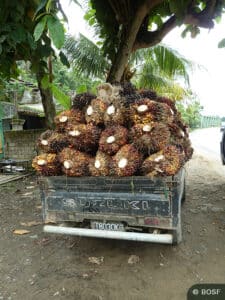palmoil
It’s almost everywhere – in cosmetics, cleaning agents, pet food, and most notably, in biofuels. The majority of palm oil originates from Indonesia and Malaysia, and it’s devastating the habitat of orangutans.
The controversial topic of palm oil
Currently, palm oil is the world’s most widely produced vegetable oil, accounting for about one-third of total global oil consumption (approximately 70 million metric tons annually). This is due to its cost-effectiveness and popularity stemming from its chemical properties: palm oil is flavor-neutral, boasts a long shelf life, exceptional heat stability, maintains a solid consistency at room temperature, and does not require chemical hydrogenation.
It is estimated that currently, almost every second supermarket product contains palm oil. These encompass groceries, especially processed items, as well as cosmetics such as lipsticks or sunscreens, detergents, paints and varnishes, and candles. A significant consumer is the automotive industry, with about half of the palm oil consumed in Germany allocated for biodiesel production. Globally, only around five percent of the palm oil harvest has been used in the energy sector so far. In many Asian countries, palm oil serves as an everyday food staple and is used for frying and deep-frying.

Which countries have large scale palmoil cultivation?
The oil palm (Elaeis Guineensis) originally hails from West Africa, thriving exclusively in tropical climates, particularly in regions densely covered by lush forests. It was initially introduced to Indonesia in 1848. Since then, the expanse of oil palm cultivation has grown exponentially: in Indonesia, oil palm plantations now span an area ten times larger (at least 14 million hectares) than they did in 1990. Globally, palm oil cultivation has multiplied sixty-fold compared to 1961, encompassing at least 20 million hectares worldwide, which is greater than half the size of Germany.
In Indonesia, oil palms are predominantly cultivated on the islands of Sumatra and Borneo, with increasing expansion observed on Sulawesi and Papua. Malaysia is another major palm oil producing country, and collectively, these two nations presently account for approximately 85 percent of the world’s palm oil production. Expansion of palm oil plantations is also being observed in other regions, including Latin America and Africa.
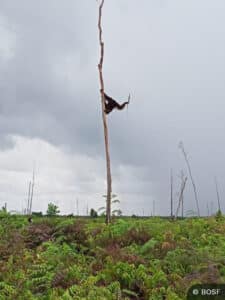 In which countries are oil palms cultivated on a large scale?
In which countries are oil palms cultivated on a large scale?
The situation of orangutans in Borneo is critical. Approximately 50 percent of all orangutan populations have been wiped out. In just the past decade, the number of these animals has decreased by 25 percent. Today, the Borneo orangutan is among the critically endangered species on our planet. There are only about 57,000 individuals left on Borneo, and the remaining orangutan groups are often isolated from each other, making it challenging for the necessary genetic exchange for long-term survival.
Over 50 percent of all orangutans in Borneo live outside protected areas. This means that their habitats are potentially threatened and at risk of permanent destruction. Numerous factors jeopardize the survival of these peaceful great apes, contributing to their current endangered status.
The Orangutan’s Habitat Is Under Threat of Extinction
Alongside poaching and wildlife trafficking, habitat loss stands as one of the primary reasons orangutans face endangerment. The continuous growth in population in Indonesia and globally has led to an increased demand for raw materials, food, and consumer goods. To meet this demand, more and more land is being cultivated. In Indonesia, agricultural expansion often results in large-scale deforestation, consequently leading to the loss of orangutan habitats.
Scientists estimate that between 2005 and 2015, oil palm cultivation on Borneo (Indonesia and Malaysia) was responsible for 50 percent of deforestation. Furthermore, approximately 20 percent of orangutans currently reside in areas earmarked for palm oil cultivation. These are regions where rainforests still exist but where licenses for conversion into palm oil plantations have either been granted to companies or are under consideration. It is estimated that by 2025, up to an additional 37 percent of the orangutans’ present habitat could be lost.
Rapid deforestation
In addition to the direct threat to Borneo’s rainforests resulting from the cultivation of oil palms, there are other ‘deforestation drivers.’ These include (illegal) logging, for example. Mining (e.g., for gold or coal) is also destroying large areas of forest, and even small-scale agriculture is partly responsible for the dwindling rainforests. The problem is that without real alternatives, the growing population is often economically dependent on agriculture. Alongside rice and rubber, the oil palm is one of many crops that farmers cultivate.
Another issue is slash-and-burn agriculture, which converts rainforests into agricultural land for oil palm plantations or general farming. Especially during the dry season, fires often get out of control and subsequently destroy vast areas of forest.

Are palm oil plantations threatening biodiversity and, more specifically, the rainforests?
As demonstrated above, valuable rainforests in Borneo, as in the case of the orangutan, have often been and continue to be destroyed for the cultivation of oil palms. These rainforests serve as the habitat for thousands of animal and plant species, some of which are endangered. Without the rainforest, their survival is at risk. Therefore, the clearing of rainforests for large-scale oil palm cultivation undeniably poses a threat to biodiversity. Indonesia’s rainforests, which account for just one percent of the Earth’s surface, are home to ten percent of all species worldwide! This is why the clearing of rainforests carries such profound implications: oil palm plantations host 65 to 90 percent fewer mammal species compared to intact rainforests. Moreover, this development significantly impacts the flora: because oil palms are grown as monocultures, oil palm plantations contain up to 99 percent fewer tree species than primary forests. Scientists estimate that oil palm cultivation threatens 193 animal and plant species worldwide.
How is palm oil cultivation connected with climate change?
The clearance of Borneo’s rainforests for palm oil cultivation is accelerating global climate change as it entails the loss of millennia-old carbon stores in vegetation and soil, resulting in the release of substantial amounts of greenhouse gases. A commercial palm oil plantation stores less than half as much carbon per hectare as a rainforest. Moreover, approximately 20 percent of palm oil plantations in Indonesia and Malaysia are established on peat soil, which must be drained before use. Peat swamp rainforests contain up to 50 times more carbon (about 6,000 metric tons) than a ’normal’ rainforest with mineral soil. The layers of peat, some several meters thick, become exposed to weather effects when drained and are highly flammable. Degraded peat soil can emit greenhouse gases for up to 600 years. Additionally, wastewater and waste disposal in palm oil mills produce significant amounts of climate-damaging gases.
Due to the unsustainable use of its natural resources, Indonesia now ranks as the world’s third-largest greenhouse gas emitter. According to current estimates, biofuel produced from palm oil is up to three times more harmful to the climate than fuel made from crude oil. Local climate impacts associated with oil palm cultivation in Borneo have already been observed. For instance, temperatures in palm oil plantations can be up to 6.5 degrees higher than in primary forests, and areas with high deforestation have recorded reduced precipitation. In other words, it’s a disaster for nature.
What are the implications of oil palm cultivation for the local population?
In contrast to its environmental impact, palm oil cultivation does not bring solely negative social implications. It can help alleviate poverty and contribute to the livelihoods of entire families, especially in regions with limited economic alternatives. Currently, there are approximately 2.5 million small-scale farmers in Indonesia who cultivate oil palms on their own land. An additional 1.5 million people work in the palm oil industry, including as plantation laborers for large palm oil companies. In Indonesia, it is estimated that around 35 percent of palm oil plantations are operated by small-scale farmers, while the remaining percentage is managed by large-scale industrial plantations operated by corporations.
Unfortunately, human rights violations remain common in industrial palm oil cultivation, a problem we have seen in other agricultural commodities like cocoa. Evictions of indigenous and local communities from their land, the criminalization of small-scale farmers, disregard for labor rights, and child labor are among the negative impacts on local populations. Communities that have resided on their land for generations face expropriation, particularly in Indonesia and Malaysia, where no comprehensive land registry exists to document land ownership. Large corporations exploit this situation when acquiring or leasing land with little regard for traditional rights. Protests are often met with violence, since the police and the military is backing the corporations. Workers on large plantations receive low wages, are subjected to unattainable harvest quotas, and lack social security coverage. Environmental degradation also has adverse consequences for the population, with many communities reporting rivers polluted by pesticides and fertilizers, as well as water shortages or floods caused by industrial palm oil cultivation.
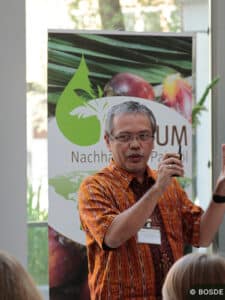 What about sustainable palm oil?
What about sustainable palm oil?
Palm oil cultivation has expanded very rapidly in recent decades, at the expense of vulnerable rainforests. Today, vast industrial monocultures dominate where rainforest once existed.
However, palm oil can actually be cultivated sustainably. It’s not the oil palm itself that is unsustainable, but rather irresponsible cultivation. This means that even with palm oil, what really matters is how it is being produced. To ensure sustainability, production must be environmentally and socially compatible.
For this reason, several initiatives now exist that have developed standards for more sustainable cultivation of oil palms. A minimum standard for the cultivation of palm oil is offered by the “Roundtable on Sustainable Palm Oil” (RSPO), which was founded by the WWF and representatives of the palm oil industry. The RSPO applies relatively strict criteria, including no clearing of rainforests for palm oil plantations, no new plantations on peat soil, and no child labor, among others.
Yet, many problems still exist on the ground. Violations of the RSPO criteria occur frequently on the plantations. While a reduction in greenhouse gases resulting from certified cultivation could be demonstrated, along with less clearing of primary forests than with conventional palm oil cultivation, there is still insufficient evidence that RSPO certification can effectively protect biodiversity.
In addition to the RSPO, there are also a few examples of organic palm oil cultivation, for example in Ghana or Colombia. Unfortunately, this has not yet been the case in Indonesia or Malaysia.
Countries importing palm oil rarely enforce mandatory sustainability standards. Even in Germany, palm oil linked to human rights violations or rainforest deforestation has not yet been made illegal. Currently, only about 20 percent of the palm oil produced worldwide is certified with an internationally recognized sustainability seal. This is simply insufficient for achieving large-scale nature conservation and safeguarding human rights in palm oil cultivation. For this reason, there are also initiatives in Germany advocating for more sustainable palm oil cultivation. The “Forum Nachhaltiges Palmöl (FONAP)” aims to only use palm oil with a sustainability seal. BOS Germany is a member of FONAP, as we want to ensure a voice for the orangutans in industry and government circles and work towards effective species protection as a mandatory requirement in palm oil cultivation.
In other words, certification is certainly better than none at all. Nevertheless, the road to true sustainability remains long. Both in Germany and in Indonesia, a legal basis must be established and enforced so that no further rainforest destruction and human rights violations are committed in palm oil cultivation.
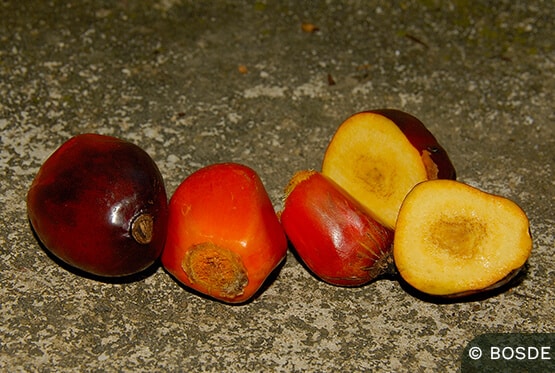
The fruits of the palmoil palm
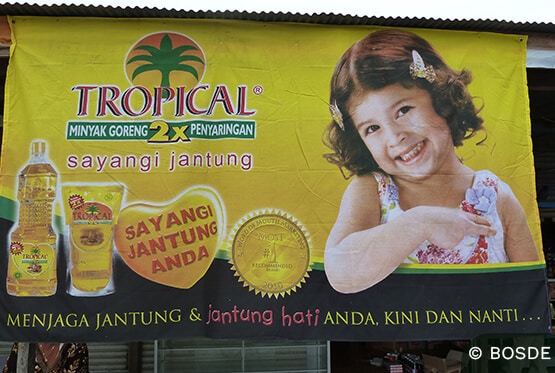
Advertising palmoil products
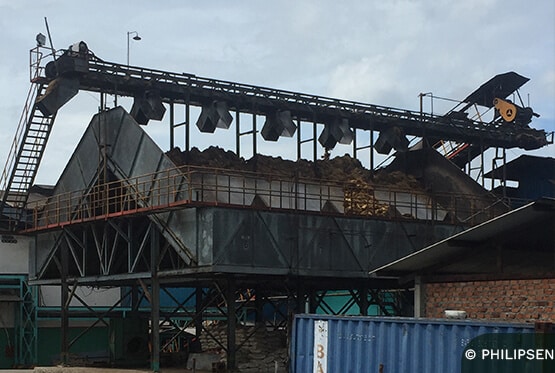
Palmoilmills
Should we avoid palm oil?
Considering the numerous negative effects of palm oil cultivation, this is an obvious question. However, palm oil is not inherently bad. The oil palm is, in fact, a highly efficient plant. It can meet a significant portion of the world’s demand for vegetable oils while requiring relatively small areas for cultivation. Additionally, oil palms need fewer fertilizers and pesticides compared to other crops. The productivity of oil palms surpasses that of any other oil crop, such as coconut, sunflower, rapeseed, or soybeans. Oil palms can yield four to seven times more per unit of land than other oil crops. While oil palms yield an average of 3.3 metric tons per hectare, canola, coconut, and sunflower only yield about 0.7 metric tons on average. Soybean plantations have an even lower yield, producing just 0.4 tons of oil per hectare. This means that producing the same amount of an alternative vegetable oil would require a significantly larger area of cultivation.
Emerging and developing countries, such as Indonesia, also have a right to economic development. Many jobs in Indonesia now depend on palm oil cultivation and trade. Germany is one of the recipient countries of Indonesian palm oil. A complete boycott of palm oil could lead to the loss of crucial income sources for people in oil-producing countries, and it would necessitate significantly more agricultural land worldwide for alternative oil crops. This would only transfer environmental problems to other regions. Completely replacing palm oil with other tropical oils, like coconut, is not a viable solution. It would likely result in even more rainforest clearance to meet the demand.
Oil crops cultivated in ecologically less sensitive regions with higher social standards, such as canola and sunflower in Germany, could serve as substitutes for oil palms. However, even in Europe, arable land is limited, and human rights violations in agriculture cannot be entirely ruled out. Conscious consumption is, therefore, more important than simply replacing palm oil with other oils. The best approach is to consume less overall and seek sustainability certifications when purchasing products containing palm oil.
What are the BOS Germany demands on palmoil
Our summarized demands to the palmoil industry and the politicians in Indonesia, Germany and the European Union
- No expansion of palm oil plantations in forest areas or other unique ecosystems.
- No cultivation of oil palms on peat soil — instead rehabilitation of peatlands.
- Orangutan and biodiversity protection on all plantations.
- Reforestation of deforested, unused areas with agroforestry systems and combinations of natural tree species with a corridor function for endangered species.
- Mandatory sustainability certification with recognized seals on all plantations and throughout the palm oil supply chain, both for producing and processing companies.
- Continuous improvement of and strict compliance with sustainability standards, including consistent prosecution of violations.
- Product traceability across the entire supply chain, beginning at the plantation.
- Support for small-scale farmers with certifying and implementing sustainable farming practices and with increasing productivity.
- Additional, sustainable sources of income for the population. Around BOS rehabilitation areas, for example, BOS works with local people to promote sustainable village development and establish alternative sources of income to palm oil that are in line with environmental conservation.
- Respect for and protection of land and human rights.
- No palm oil in biofuels.
Make a donation for the orangutans
Make a one-time donation
Orangutans need our help! With your donation for the orangutans you accompany and support an orangutan on its journey until its release into the wild.
Make a donation for the orangutans
Make a one-time donation
Orangutans need our help! With your donation for the orangutans you accompany and support an orangutan on its journey until its release into the wild.
Frequently asked questions
Could palmoil be harmful?
Your Subtitle Goes Here
The clearing of Borneo’s rainforests for agriculture and the creation of palm oil plantations are accelerating climate change and threatening biodiversity. In addition, rivers become polluted by the fertilizers and pesticides used on plantations. Health hazards from palm oil consumption have not yet been fully assessed, although there are some warnings: The European Food Safety Authority (EFSA) announced in mid-2016 that palm oil could cause cancer. Caution is advised, especially for babies and small children. However, the warnings do not just relate to palm oil, but to substances that are typically generated by heating vegetable fats to around 200°C and have been shown in animal studies to be carcinogenic above certain high doses. Accordingly, the German Federal Institute for Risk Assessment (BfR) classifies them as critical as well. Primarily, glycidyl and other fatty acid esters are of concern, but in palm oil these can develop at considerably higher concentrations than in other vegetable fats. Recommended is a limit of 30 micrograms of certain fatty acid esters per day and kilogram of body weight. This means that for children, this limit is reached much earlier due to their lower weight.
Does palmoil oppose health risks?
Your Subtitle Goes Here
The harmful substances in palm oil are created during strong heating in the refining process. This does not apply, or only to a much lesser extent, to palm oil that has been processed at lower temperatures. Raw, unprocessed palm oil even contains substances such as carotene and vitamin E that are considered to be beneficial to health. The latter is even present in a variant that is particularly well absorbed by the human body. However, while crude palm oil is an everyday food staple in the countries where it is cultivated, it only plays a niche role in Germany. Crude palm oil, with its distinctive sweet-flowery, violet-like odor and characteristic deep orange color, has a semi-solid wax-like consistency at European room temperatures and is usually only available in Asia markets and some organic supermarkets. In contrast, the refined palm oil used in various food products has been bleached, deodorized, and contains almost no vitamins. It is a food-processing substance rather than a food product in its own right.
Why is palm oil used so much?
Your Subtitle Goes Here
The great advantage of palm oil compared to other vegetable oils is its comparatively high productivity. It is possible to produce 3.7 tons of oil from one hectare of land per year. In comparison, only 1.3 tons of oil can be obtained from one hectare of canola. Sunflower productivity comes to 0.9 tons of oil, coconut palm to 0.8, and soybean to 0.5 tons of oil per year per hectare. This is one of the reasons for the high profitability, the competitive price, and thus the wide applicability of palm oil.
Where does the oil palm grow?
Your Subtitle Goes Here
The oil palm is originally from West Africa, but found a new home in Indonesia and Malaysia long ago. By now, it has even made it to South America and is industrially cultivated in Colombia and Brazil, among other places.
How can I find out if a product contains palm oil?
Your Subtitle Goes Here
This information should be included in the ingredient list of a product. Unfortunately, the word palm oil is often substituted by the term vegetable fat or other chemical names that do not clearly indicate that it is palm oil. There are some Apps that provide this information after scanning the barcode.
Which products contain palm oil?
Your Subtitle Goes Here
Palm oil is used, for example, in instant soups, in all kinds of baked goods, in chocolate bars and filled chocolates, and in many other processed foods. Palm oil is also a common ingredient for cosmetics, detergents and so-called biofuel. Basically, we can hardly get around it in our everyday lives. A look at ingredient lists provides some insight.

You have a question?
Donations are a matter of trust
Transparent use of funds is a matter of course for us. In September 2013, we joined the a non profit initiative of Transparency International Germany and signed its declaration of commitment.
